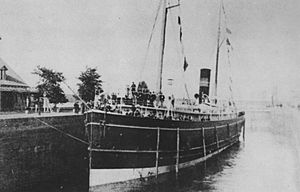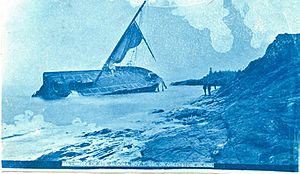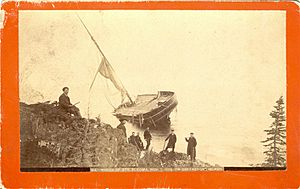SS Algoma
 |
|
Quick facts for kids History |
|
|---|---|
| Name | Algoma |
| Operator | Canadian Pacific Railway Company |
| Builder | Aitken & Mansell |
| Launched | July 31, 1883 |
| Out of service | November 7, 1885 |
| Fate | Sank off the shore of Isle Royale in Lake Superior |
| General characteristics | |
| Type | Screw steamer |
| Tonnage | 1,773 GRT |
| Length | 262 ft (80 m) |
| Beam | 38 ft (12 m) |
| Depth | 23 ft (7 m) |
| Notes | Official #85766 |
|
Algoma
|
|
| Location | Southeast shore of Mott Island, Isle Royale National Park, Michigan |
| Area | 45.7 acres (18.5 ha) |
| Built | 1883 |
| Architect | Aitken & Mansell |
| Architectural style | Screw Steamer |
| MPS | Shipwrecks of Isle Royale National Park TR |
| NRHP reference No. | 84001699 |
| Added to NRHP | June 14, 1984 |
The Algoma was a large ship called a screw steamer, built in 1883. This means it used a propeller (like a giant fan) underwater to move. The ship sadly sank in 1885 near Isle Royale National Park in Lake Superior. Parts of the Algoma are still on the lake bottom today. Because of its history, the wreck was added to the National Register of Historic Places in 1984.
Contents
Building the Algoma Ship
The Algoma (Official #85766) was built in 1883 in Glasgow, Scotland. It was made for the Canadian Pacific Railway Company. The ship was about 262 feet (80 m) long, which is longer than two basketball courts. It was 38-foot (12 m) wide and 23 feet (7 m) deep.
Ship Design and Features
When first built, the Algoma weighed 1,750 tons. It had a special compound steam engine that turned a single propeller. It also had two masts with sails. These sails were a backup in case the engine stopped working. The ship was designed to carry many people. It could hold 240 first-class passengers and 500 other passengers.
Sister Ships and Journey to the Great Lakes
The Canadian Pacific company ordered three identical ships from the same builder. These were the Athabasca, Alberta, and Algoma. The Athabasca was launched on July 3, 1883. The Alberta followed on July 12, and the Algoma on July 31.
These ships were meant to carry passengers on the Great Lakes. They would travel from Thunder Bay on Lake Superior to Owen Sound on Lake Huron. The Alberta and Algoma left Scotland on September 25, 1883. They crossed the Atlantic Ocean in 13 days to reach Montreal, Quebec.
Getting Through the Canal
The Algoma was too big to fit through the Welland Canal. This canal connects Lake Ontario and Lake Erie. So, the ship had to be cut in half! The front (bow) and back (stern) parts were moved separately on special floating platforms. The ship was put back together in Buffalo, New York.
More cabins were added, making the ship weigh 1,773 tons. During the winter of 1883–1884, electric lights were installed. The Algoma and its sister ships were likely the first Great Lakes ships to have electricity. The newly finished Algoma cost $450,000 to build. It was launched again on May 11, 1884.
Setting Speed Records
The three Canadian Pacific ships quickly became known for their speed. The Algoma traveled from Owen Sound to Thunder Bay in just under 40 hours. It also made a trip from Toronto to Thunder Bay in a very fast 47 hours. Some people worried that the ships were going too fast. In July 1884, the Alberta was in a crash with another ship, the John M. Osborn. Three people lost their lives in that accident.
The Wreck of the Algoma
On November 5, 1885, the Algoma left Owen Sound for Thunder Bay. It was carrying goods, railway supplies, and 37 passengers. This was the fewest passengers it had ever carried. This might have been because it was late in the season. Also, a new train route around Lake Superior had just opened.
Stormy Weather and Grounding
The ship entered Lake Superior on November 6. When it was about halfway across the lake, it sailed into a terrible snowstorm. The crew put up the sails to help steady the ship. However, the ship drifted off its planned path.
Around 4:00 AM on November 7, the captain ordered the sails down and changed course. At 4:40 AM, soon after the engine started again, the Algoma ran aground. It hit the southeast shore of Mott Island, near Isle Royale.
Ship Breaking Apart
The ship was stuck in a way that waves crashed hard against its front part. Around 6:00 AM, the ship broke into two pieces. The back part stayed stuck on the shore. The front part drifted away. Many passengers and crew were swept into the water.
However, three people managed to reach the shore, which was only 50 feet, 15 m away. Another 11 people stayed on the front part of the ship. They waited there until the morning of November 8, when the storm calmed down.
Survivors and Rescue
All the survivors reached the shore on November 8. They spent that night with some fishermen. On November 9, another ship, the Athabasca, was found. The survivors were then taken to Thunder Bay.
Forty-six people died in the Algoma wreck. There were 14 survivors. These included two passengers, 11 crew members, and the captain. A search team went back to Isle Royale on November 10. They found only two bodies. More bodies and cargo were found in the following months. The storm was so strong that almost all the cargo was destroyed. Some parts of the ship's hull were completely flattened.
The sinking of the Algoma was the worst loss of life in the history of shipping on Lake Superior.
Salvage Operations
Much of the back part of the ship was saved in 1886. Most of the front part was either salvaged or floated away. The engine from the Algoma was later used in another passenger ship called the Manitoba. The Manitoba was launched in 1889 and was used on the Great Lakes for 60 years. Another salvage effort happened in 1903.
The Algoma Wreck Today
The remaining parts of the Algoma wreck are spread out in water that is 15 to 100 feet (5 to 30 m) deep. Only some pieces of the stern (back part) are still at the site. The wreckage near the shore is mainly in three areas, about 100 feet apart.
What Divers Can See
Divers can see different parts of the ship's equipment. These include pieces of a mast, pipes, valves, and davits (small cranes for lowering boats). You can also find items that belonged to the passengers. Much of the wreck is in shallow water. The lake's waves often move the artifacts around. A few pieces of the wreck have been found far offshore in deeper water. These might be from the missing front part of the ship.
The Algoma is the least visited shipwreck in the Isle Royale National Park. In 2009, only about 10 dives were made to this wreck. This is out of 1,062 dives made to all the wrecks in the park that year.





